Serving 488 students in grades Prekindergarten-5, St. Simons Elementary School ranks in the top 20% of all schools in Georgia for overall test scores (math proficiency is top 20%, and reading proficiency is top 20%).
The percentage of students achieving proficiency in math is 57% (which is higher than the Georgia state average of 37%). The percentage of students achieving proficiency in reading/language arts is 55% (which is higher than the Georgia state average of 40%).
The student:teacher ratio of 13:1 is lower than the Georgia state level of 14:1.
Minority enrollment is 43% of the student body (majority Black), which is lower than the Georgia state average of 65% (majority Black).
Quick Stats (2025)
- Grades: Prekindergarten-5
- Enrollment: 488 students
- Student:Teacher Ratio: 13:1
- Minority Enrollment: 43%
- Overall Testing Rank: Top 20% in GA
- Math Proficiency: 57% (Top 20%)
- Reading Proficiency: 55% (Top 20%)
- Science Proficiency: 55-59% (Top 20%)
- Source: National Center for Education Statistics (NCES), GA Dept. of Education
Top Rankings
St. Simons Elementary School ranks among the top 20% of public schools in Georgia for:
Category
Attribute
Overall Rank
Math Proficiency
Reading/Language Arts Proficiency
Science Proficiency
School Overview
St. Simons Elementary School's student population of 488 students has declined by 17% over five school years.
The teacher population of 39 teachers has stayed relatively flat over five school years.
Grades Offered
Grades Prekindergarten-5
Total Students
488 students
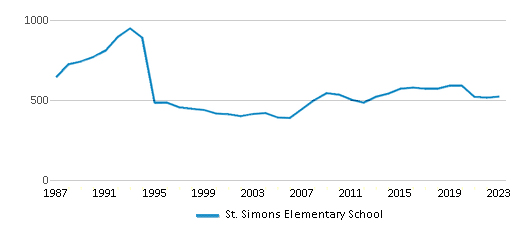
Gender %
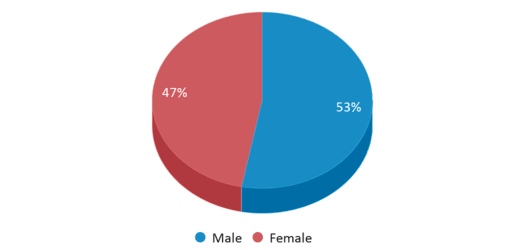
Total Classroom Teachers
39 teachers
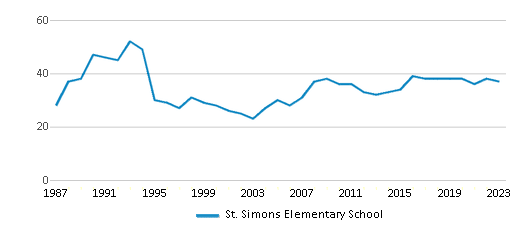
Students by Grade
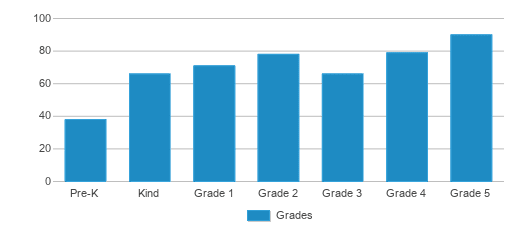
School Rankings
St. Simons Elementary School ranks within the top 20% of all 2,204 schools in Georgia (based off of combined math and reading proficiency testing data).
The diversity score of St. Simons Elementary School is 0.61, which is less than the diversity score at state average of 0.71. The school's diversity has stayed relatively flat over five school years.
Overall Testing Rank
#329 out of 2204 schools
(Top 20%)
(Top 20%)
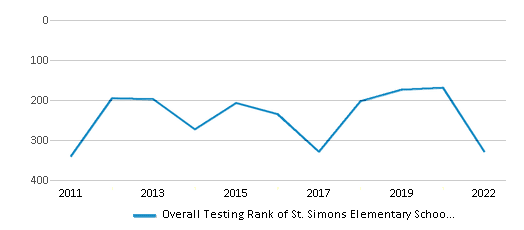
Math Test Scores (% Proficient)
57%
37%
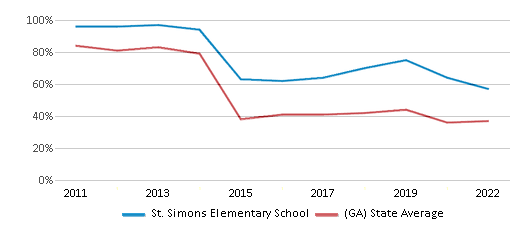
Reading/Language Arts Test Scores (% Proficient)
55%
40%
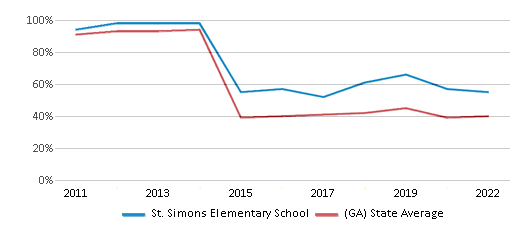
Science Test Scores (% Proficient)
55-59%
40%

Student : Teacher Ratio
13:1
14:1

American Indian
n/a
n/a
Asian
1%
5%
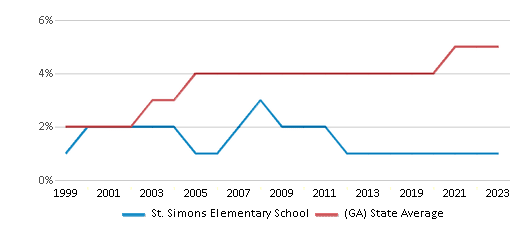
Hispanic
17%
19%

Black
19%
36%
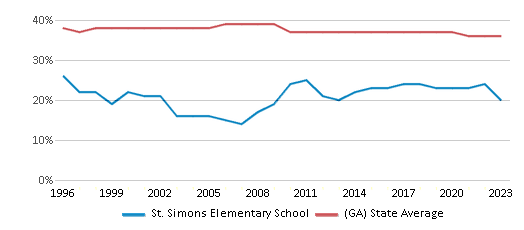
White
57%
35%
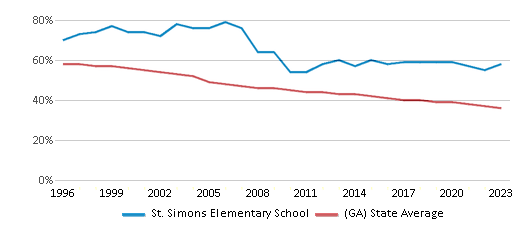
Hawaiian
n/a
n/a
Two or more races
6%
5%
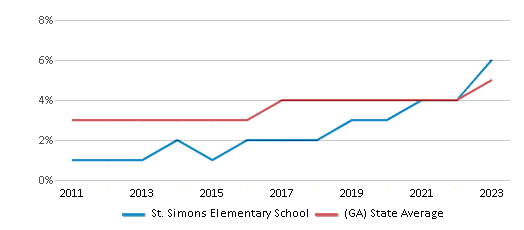
All Ethnic Groups
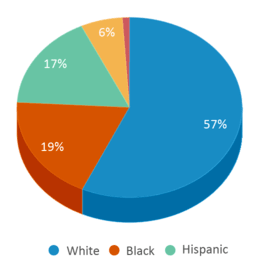
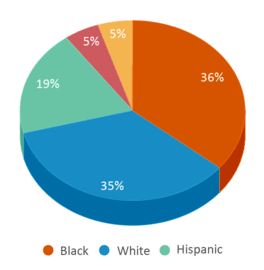
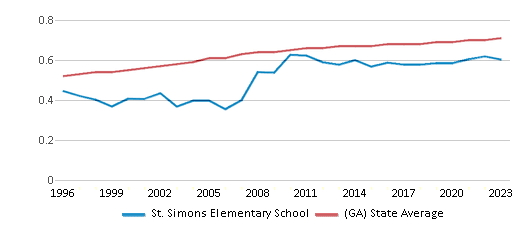
Eligible for Free Lunch
51%
59%
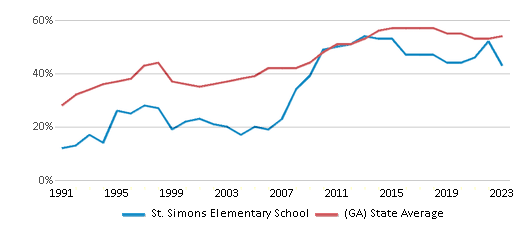
Eligible for Reduced Lunch
6%
5%
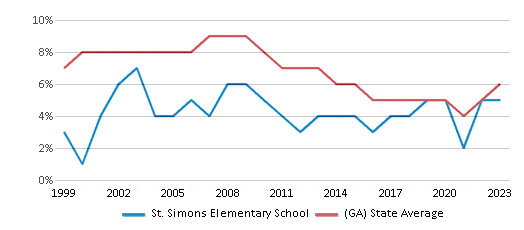
School Statewide Testing
School District Name
Source: National Center for Education Statistics (NCES), GA Dept. of Education
Profile last updated: 02/09/2025
Frequently Asked Questions
What is St. Simons Elementary School's ranking?
St. Simons Elementary School is ranked #329 out of 2,204 schools, which ranks it among the top 20% of public schools in Georgia.
What schools are St. Simons Elementary School often compared to?
St. Simons Elementary Schoolis often viewed alongside schools like Oglethorpe Point Elementary School, Satilla Marsh Elementary School by visitors of our site.
What percent of students have achieved state testing proficiency in math and reading?
57% of students have achieved math proficiency (compared to the 37% GA state average), while 55% of students have achieved reading proficiency (compared to the 40% GA state average).
How many students attend St. Simons Elementary School?
488 students attend St. Simons Elementary School.
What is the racial composition of the student body?
57% of St. Simons Elementary School students are White, 19% of students are Black, 17% of students are Hispanic, 6% of students are Two or more races, and 1% of students are Asian.
What is the student:teacher ratio of St. Simons Elementary School?
St. Simons Elementary School has a student ration of 13:1, which is lower than the Georgia state average of 14:1.
What grades does St. Simons Elementary School offer ?
St. Simons Elementary School offers enrollment in grades Prekindergarten-5
What school district is St. Simons Elementary School part of?
St. Simons Elementary School is part of Glynn County School District.
School Calendar
View the St. Simons Elementary School yearly calendar below. Note key dates such as:
Event
Date
Spring Break Holidays (Events)
March 31, 2025 (Monday)
Spring Break Holidays (Events)
April 01, 2025 (Tuesday)
Spring Break Holidays (Events)
April 02, 2025 (Wednesday)
Spring Break Holidays (Events)
April 03, 2025 (Thursday)
Spring Break Holidays (Events)
April 04, 2025 (Friday)
School Reviews
5 7/21/2020
First grade teacher Mrs. Culver was amazing just what my son needed she, the assistant principal and the principal all showed true concern for my son. They all wanted my son to succeed, and he did. They looked out for him and kept in close contact with me. I appreciate the help they offered and how they went above and beyond even helping my little guy find his jackets his lost almost weekly. Love this school.
4 5/19/2020
Dedicated staff and teachers that make this school's academic work for a broad population.
2 9/12/2012
Great school except for Pre-K program.
Review St. Simons Elementary School. Reviews should be a few sentences in length. Please include any comments on:
- Quality of academic programs, teachers, and facilities
- Availability of music, art, sports and other extracurricular activities
Recent Articles

What Is A Charter School?
Explore the world of charter schools in this comprehensive guide. Learn about their history, how they operate, and the pros and cons of this educational innovation. Discover key facts about charter schools, including admission policies, demographics, and funding, as well as what to look for when considering a charter school for your child.

10 Reasons Why High School Sports Benefit Students
Discover the 10 compelling reasons why high school sports are beneficial for students. This comprehensive article explores how athletics enhance academic performance, foster personal growth, and develop crucial life skills. From improved fitness and time management to leadership development and community representation, learn why participating in high school sports can be a game-changer for students' overall success and well-being.

February 05, 2025
Understanding the U.S. Department of Education: Structure, Impact, and EvolutionWe explore how the Department of Education shapes American education, from its cabinet-level leadership to its impact on millions of students, written for general audiences seeking clarity on this vital institution.







